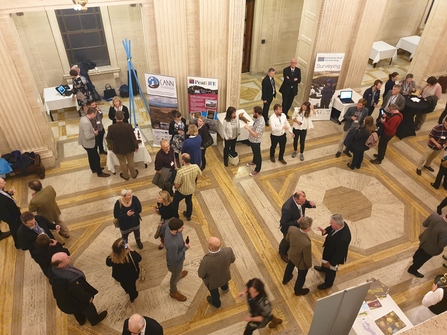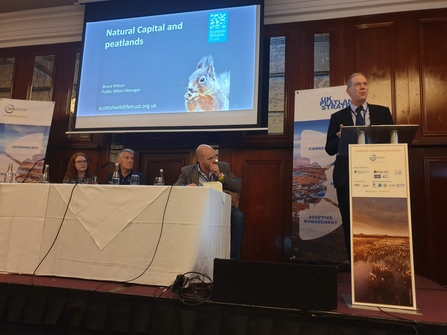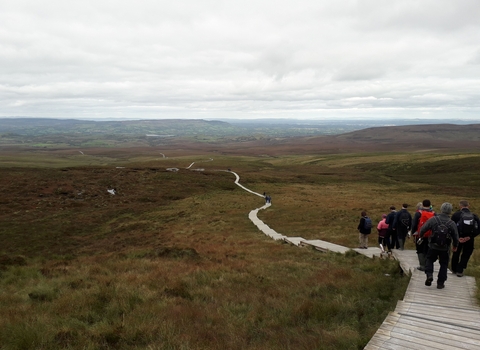This, the 9th in our conference series, celebrated the 10th year of the IUCN UK Peatland Programme partnership. A huge amount has been achieved by the UK peatland community over the last 10 years. There is a growing appreciation of the vital role peatlands play in addressing the climate change and biodiversity crises we now face – investing in peatland health is investing in the future.
This year's conference included peatland field trips, a formal networking evening at Stormont Parliament Buildings sponsored by Cathal Boylan, Sinn Féin spokesperson on Environment, Energy & Climate and Pam Cameron, Democratic Unionist Party and poster exhibition..
221 local, national and international delegates and volunteers from across sectors came together over 3 days to explore themes including:
- UK peatlands in an international context
- Progress made towards UK Peatland Strategy goals
- Update on key peatland topics: Commission of Inquiry
- Peatlands and Climate Change
- Natural Capital & Innovative Investment
- Evidence & priority research needs and break-throughs
- Building support for Peatland Protection & Restoration
- Restoration challenges, new developments & best practice.
With investing in the future in mind, over the three days the conference highlighted progress made towards UK Peatland Strategy goals within an the international context as well as sharing emerging evidence, including reviews of key topics and innovative investment opportunities. Discussions were facilitated on current challenges and new ideas around: peatland restoration; prioritising research and monitoring and engaging with key stakeholders both strategically and on the ground.

Credit Emma HInchliffe
Day 1 speaker presentations
Over 200 delegates joined us for the conference opening address which was kindly provided by Sandeep Sengupta, Global Coordinator of IUCN's Climate Change Portfolio, Global Policy & Programme Group with an introduction to the pivotal role peatlands play in addressing climate change, and a welcome from our hosts provided by Helen Anderson, Director of Natural Environment Division, Northern Ireland Environment Agency, Department of Agriculture, Environment and Rural Affairs (DAERA).
An international perspective
This session shared progress from the Global Peatlands Initiative and partners, including monitoring of IUCN Resolution 43.
- Developing Core Common Outcomes for Tropical Peatland Research and Management: Mark Reed (IUCN UK Peatland Programme)
- Selected Global Peatlands Initiative highlights in 2019 and a spotlight on Germany: Franziska Tanneberger (Greifswald University)
- Providing an international perspective on peatlands: Dianna Kopansky (Global Peatlands Initiative) (see video below)
UK Strategy progress
This session shared updates from the four countries on delivery of the UK Peatland Strategy.
- An overview of the UK Peatland Strategy: Stuart Brooks (IUCN UK Peatland Programme)
- England Peat Strategy update: Sophie Chapman (Defra)
- Restoring Northern Ireland's peatlands: Sara McGuckin (Northern Ireland Environment Agency, Natural Environment Division)
- Scottish update: Andrew Coupar (Scottish Natural Heritage)
- Peatland progress - Wales: Peter Jones (Natural Resources Wales)
Commission of Inquiry update
An introduction to the Commission of Inquiry process and overview of the key topics under review:
- Biodiversity Monitoring: Emma Goodyer (IUCN UK Peatland Programme)
- Peatland Catchments and Natural Flood Management: Tim Allott (University of Manchester)
- Peatlands and forestry - forest to bog restoration: Peter Robson (ScottishPower Renewables)
Lowland peatlands & wet agriculture
- Paludiculture: Paludifuture for the UK’s fen peatlands?: Sarah Johnson (Lancashire Wildlife Trust)
- Innovate UK: Sphagnum Farming UK - a sustainable alternative to peat in growing media: Jack Clough and Richard Lindsay (University of East London)
Climate change, peatlands and greenhouse gas accounting
- Update on the State of the UK Peatlands: Rebekka Artz (James Hutton Institute)
- Quantifying the carbon balance of lowland peatlands: Ross Morrison (Centre of Ecology and Hydrology)
- Climate benefits from forest-to-bog restoration on deep peat - a case study in the Flow Country: Mhairi Coyle (James Hutton Institute)
Peatland funding and finance news
- Natural capital and peatlands: Bruce Wilson (Scottish Wildlife Trust)
- Peatland Code progress: Jillian Hoy (IUCN UK Peatland Programme)
- Funding the AfterLIFE: Peatland funding post-BREXIT: Tim Thom (Pennine PeatLIFE)

Credit Emma Hinchliffe
Day 3 discussions
Peatland Restoration - emerging ideas and current challenges
A: Problems, potential and best practice? Peatland archaeology, heritage and related issues
In this session delegates were encouraged to share their experiences and knowledge of archaeology, heritage and related issues in the context of peatland conservation and restoration programmes.
- The Cinderella syndrome? Archaeology and peatland restoration: Dr Ben Gearey (University College Cork)
- Exmoor : A Case Study, peatland restoration and the historic environment: Morag Angus (Exmoor Mires Partnership)
- WetFutures? Peatland Heritage, Perception, Protection and Policy: Dr Kim Davies (University College Cork)
B: Approaches to vegetation cutting for conservation management purposes.
This session explored the use of vegetation cutting as a peatland restoration tool - promoting
discussion around the scenarios and peatland habitats in which vegetation cutting may be used to
achieve restoration goals and presented new technical approaches, knowledge gaps and areas for
development.
- An introduction to vegetation cutting approaches across peatland habitats: Iain Diack (Natural England)
- Using the Pistenbully to achieve site based raised bog restoration goals: Jack Simpson (LIFE Welsh Raised Bogs)
- Using state of the art cutting machinery to achieve site based blanket bog restoration goals: Erin Madden (Moors for the Future Partnership)
C: The role of the peatland restoration community in going peat-free
This session shared experiences from both peatland restoration partnerships who have adopted
peat-free purchasing policies - excercising their purchasing power to reduce demand for horticultural
products grown in peat, as well as the innovations and challenges associated with supplying
peat-free peatland plants for landscape scale restoration.
- Going peat-free in practice: a peatland restoration partnership perspective: Alistair Lockett (Pennine PeatLIFE)
- Going peat-free in practice: innovations and challenges of supplying peat-free plants for landscape scale restoration purposes: Neal Wright (Micropropogation Services)
D: Restoration of milled peat sites
This session discussed the successes, challenges and need to restore peat extraction sites.
- Rehabilitation of industrial cutaway peatlands: David Fallon (Bord na Móna)
- Restoring milled peat sites: successes, challenges, lessons learnt from Bolton Fell moss and Wedholme flow: Deborah Land & Emma Austin (Natural England, Cumbrian Bogs LIFE+)
Prioritising monitoring, research and evidence
A: Peatland condition assessment and monitoring
This session discussed ways of evaluating peatland condition from low-tech solutions to virtual reality (VR) visualisations.
- Describing peatland condition through simple, consistent and robust monitoring: 'Eyes on the Bog' and beyond: Richard Lindsay (University of East London)
B: Peatland Exposure to Atmospheric Nitrogen Deposition
This session discussed researching ecosystem sensitivity, response and recovery of peatland habitats exposed to atmospheirc nitrogen deposition.
- Nitrogen Deposition and the threat to our natural environment – An overview: Keith Finegan (NIEA Natural Environment Division)
- Long-term impacts of nitrogen eeposition and evidence of recovery – Whim Bog and Moninea Bog: Netty Van Dijk (Centre of Ecology & Hydrology)
- Atmospheric nitrogen input to Ballynahone Bog SAC - measuring, modelling and understanding ecological impacts: Áine O’Reilly (NIEA Natural Environment Division)
C: Filling evidence gaps to inform sustainable management.
This session introduced a research and monitoring initiative in Wales that aims to more effectively
and efficiently fill priority evidence gaps in the sustainable management of Welsh peatlands. Delegates were encouraged to help develop and deliver this initiative by sharing their experiences, feedback, ideas and opportunities.
- Developing a network of research sites across Welsh peatlands: Dr. Jonathan Walker (Swansea University)
- Identifying and filling evidence gaps towards the sustainable management of peatlands in Wales: Professor Cindy Froyd (Swansea University)
- Standardised peatland monitoring protocols to more widely and consistently monitor changes in the condition of Welsh peatlands: Dr. Alan Radbourne (Centre for Ecology and Hydrology)
D: Demonstrating ecological restoration of recovering peatland sites.
This session shared evidence from long term research and monitoring of peatland restoration sites.
- Monitoring peatland rehabilitation in Ireland – progress and challenges: Mark McCorry (Bord na Móna)
- Past, present and future of monitoring of raised bogs in Ireland by National Parks & Wildlife Service. Fernando Fernandez (National Parks & Wildlife Service)
- Blanket bog restoration monitoring at RSPB Geltsdale: Steve Garnett (RSPB)
Engaging with key stakeholders at a practical and policy level
A: Bringing peat to broad audiences
- Below the Blanket – a landscape art installation at the Royal Botanic Gardens, Edinburgh as part of the International Fringe Festival: Caroline Eccles (Flow Country Partnership)
- Engaging rural & urban audiences with the interactive, mobile Bogtastic van: Erin Madden (Moors for the Future Partnership)
- Give peat a chance: Using a giving campaign as an engagement tool: Lyndon Marquis (Yorkshire Peat Partnership)
B: Implementing policy and acknowledging international significance across peatland habitats.
- An introduction to working collaboratively across peatland habitats & with internationally significant designation: Trish Fox (Collaborative Action for the Natura Network)
- An opportunity for discussion: Establishing England Peat Strategy Pilots in a cross-section of different peatland ecosystems and farming systems: Naomi Oakley (Natural England)
- Developing a UNESCO World Heritage Site bid in the Flow Country: Joe Perry (Flow Country World Heritage Site Working Group)
C: Community driven peatland restoration and engagment
- Introduction to The Abbeyleix Bog Project, a local community project, established in 2000 to conserve and protect the bog which was threatened with harvesting for peat moss, is now responsible for its management over the next 50 years: Chris Uys (Abbeyleix & Community Wetlands Forum)
- Engaging local communities to assist with Living Bog project actions: Ronan Casey (The Living Bog Project)
D: Engaging land managers in practical restoration - Using the Peatland Code to access new
funding streams.
This session highlighted that real progress is being made with putting the Peatland Code into practice across the UK, although its not without its difficulties! The Welsh Peatlands Sustainable Management Scheme and Pennine PeatLIFE projects shared their experiences so far, and its clear that common challenges are being encountered along the way. This presents an opportunity for developing common solutions, possibly even an improved version of the Code, to help leverage the investment that UK peatlands so desperately need.
Chair: Tim Thom, Pennine PeatLIFE
- An introduction to The Peatland Code - an innovative voluntary mechanism for business to engage with peatland restoration: Jillian Hoy (IUCN UK Peatland Programme)
- Using the Peatland Code in practice - case study: Chris Miller (Pennine PeatLIFE)
- Using the Peatland Code in practice - case study: Marian Pye (Welsh Peatland Sustainable Management Scheme)
Poster session
The Poster Exhibition evening welcomed 36 poster presentations and 14 exhibition stands to share knowledge, experience, new findings, tried and tested techniques and novel approaches to peatland research, policy and practice.
Posters included:
The UK is a global leader in peatland restoration. This is only made possible by the enthusiasm and
dedication of hundreds of individuals, whether paid staff or volunteers; NGO, Government, academic,
business or private land manager. We would like to commend the whole peatland community and
particularly the partnerships that drive this work, restoring and protecting peatlands for future generations.
The 2019 IUCN UK Peatland Programme conference was delivered in partnership with DAERA, Pennine PeatLIFE, Northern Ireland Water. It was kindly sponsored by RPS and Salix River and Wetland Services Ltd. It was supported by Ulster Wildlife Trust, the RSPB, The Living Bog, Beadamoss, Visit Belfast and Scottish Wildlife Trust.










